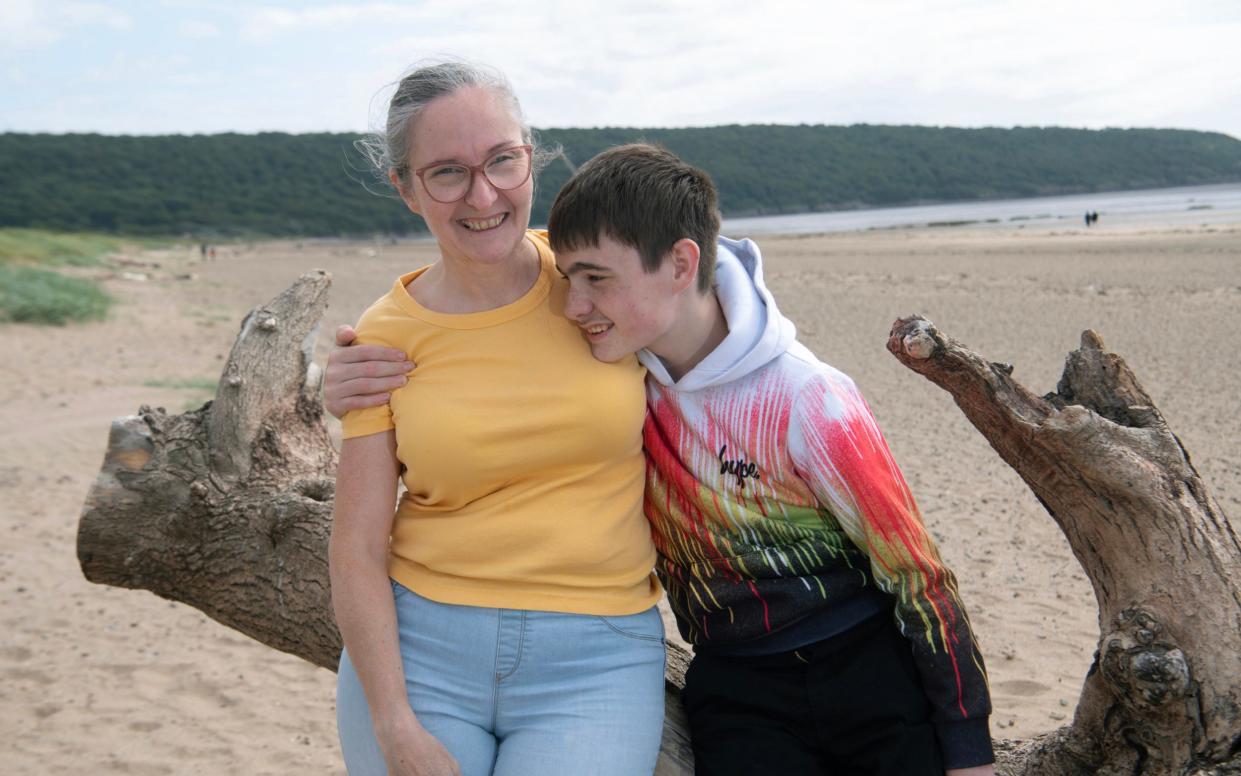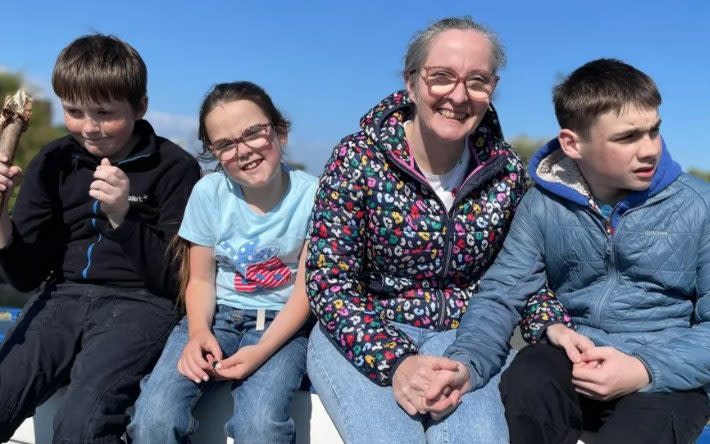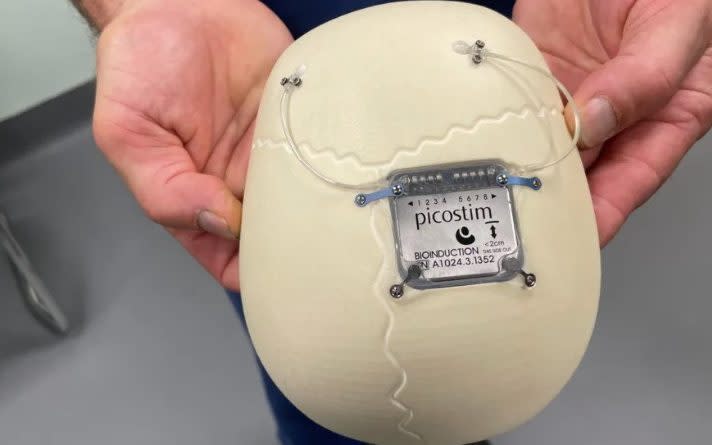My son had 300 seizures a day – but after a cutting-edge procedure there’s hope

Seizures have always run in our family. My mum and sister had seizures, I was diagnosed with epilepsy when I was a child, and all three of my children have had seizures. About three or four years ago we discovered that we have a SCN1B gene mutation which is an underlying cause of epilepsy. So we’re one big happy seizure party, although fortunately most of us grew out of it between the ages of eight and 10.
But from early on, it was clear that things would be different for Oran, my eldest child. About two or three weeks after his third birthday things changed for the worse. He had five tonic-clonic seizures – which cause stiffening, twitching and loss of consciousness – within six hours. That was March 2014, and by the September of that year he was having more than 300 seizures a day. He was eventually diagnosed with Lennox-Gastaut syndrome, a treatment-resistant form of epilepsy, and 10 years on, we haven’t had a seizure-free day since.
To say this has changed our lives is an understatement. I’d spent 15 years working as a paediatric nurse, but within a year of Oran’s first seizure, I was forced to leave that career because every single day became a matter of life or death. His seizures were so severe that he would go into full-blown respiratory arrest and stop breathing. It got to a point where I was having to resuscitate him twice a week, a terrifying ordeal to go through as a mother. No parent should ever have to experience that, seeing your child blue in the face, frantically trying to revive them. I can’t even begin to describe the pressure I felt in those moments, and if I wasn’t medically trained, Oran wouldn’t be here today.

The seizures and respiratory arrests could happen suddenly and without any warning. One of the scariest moments actually happened when I was sitting right next to him, reading a book. I thought he seemed rather quiet, and I turned around and he was completely blue. It turned out that he’d gone a minute and a half without breathing. It got to the point where everything had to be planned down to the finest detail just to ensure that I could go shopping.
Oran can’t be left unsupervised because he could literally die, so I can’t even shower unless there’s someone in the house who can keep an eye on him. Because of this, we have to have cameras everywhere, and a dedicated server in the attic to keep them all running, just so that I can make a cup of tea, cook and still watch him. Our house is like a cross between Big Brother and GCHQ.
Nights are the worst. For 10 years, I’ve regularly gone 48 hours or more without any sleep because I have to watch him, then take him and his siblings to school, and still be on call in case there’s an emergency. We eventually managed to get a care team around him for five nights a week, but even now, I still have to stay awake for the entirety of the other two nights which takes its toll, physically and emotionally.
Because my husband works night shifts as a bus driver, if Oran has a major seizure, I have to call for his younger brother Quinn who’s 11, because Oran’s now too big for me to turn over on my own. Quinn and his sister who’s eight years old, both have learning difficulties, but they’ve basically been young carers and have had to step up to perform CPR like a pro. The responsibility has had a big impact on their childhood, and they’ve had to miss out on ordinary things like going to birthday parties.
I always clung to the hope that he would grow out of it eventually, everyone else in the family had. But instead, he was getting worse and worse and worse.
Over the years, we tried at least 16 different medications, even some which are quite risky, but nothing made a real difference. Then I was fortunate to come across an article from Bristol Children’s Hospital about deep brain stimulation (DBS), and how they were using these devices in children with dystonia, another neurological condition. So I found a consultant neurologist at Great Ormond Street Hospital who was in the early stages of planning a study of DBS for Lennox-Gastaut syndrome patients; it was the only option we had left.
Eventually in the summer of 2023, we walked into Great Ormond Street Hospital to meet the team and Oran experienced a full blown seizure in front of all of them and things moved very quickly from there. Oran underwent surgery to have the device implanted in his skull in October 2023.

For my husband and I, it was a nerve-wracking experience. The week before the operation, I was a breath away from a panic attack every single day. But I took solace in the fact that the specialists needed the operation to work, just as much as we did, so he was very precious.
They gave him five weeks before they turned the device on, and the improvement was wonderful. He went from having about 150 seizures a day in the summer of 2023 to now just two or three daytime seizures most days. We haven’t had to resuscitate him since and while it isn’t a total cure, he still has night-time seizures, he can start to engage in life again.
Before, school was a challenge. Oran couldn’t have even picked up a book last September, let alone read it. But now he’s learning his phonics again, he’s reading sentences. He wants to learn to swim, and he loves gardening and riding his bike. He’s in a school for children with severe learning disabilities and he wants to ride his bike to school, so we’re going to try and make that happen, even if it means that one of his care nurses has to get on a bike and ride with him.

It hasn’t been a cure, Oran still has some seizures, but in future the specialists are going to try and adjust the frequencies of the DBS device to see whether they can eliminate them altogether. For me, it has been an enormous relief, as I no longer have to worry about resuscitating him.
Oran has a new lease of life and we now need to make sure that other families get this opportunity as well. This is bigger than just our family, and I hope that Oran will be followed by dozens of other children who will benefit from this.
As told to David Cox
How deep brain stimulation works for treatment-resistant epilepsy
As a consultant paediatric neurosurgeon at Great Ormond Street Hospital, Martin Tisdall performed the pioneering operation which saw a deep brain stimulation device called the Picostim, implanted into Oran’s brain.
Oran was the first child with Lennox-Gastaut syndrome to receive the device as part of the Cadet project, a series of clinical trials which are exploring the safety and effectiveness of deep brain stimulation in children with this condition.
“Lennox-Gastaut syndrome is a rare but very severe form of childhood epilepsy,” says Tisdall. “These children have very few effective treatment options available to them.”
As part of the operation, the Picostim, which passes low current but high frequency electrical pulses deep into the brain, was implanted in Oran’s skull, enabling it to be easily recharged through wireless headphones. The Picostim is attached to two electrodes which penetrate into a part of the brain called the thalamus.
“The pulses disrupt the abnormal patterns of electrical activity that cause seizures,” explains Tisdall. “The thalamus is kind of a key gateway hub because it’s highly connected to important areas in the brain. By disrupting the flow of abnormal activity from this hub, we can prevent a seizure from taking root.”
After Oran’s success, Tisdall’s team have now implanted the device in two further patients with Lennox-Gastaut syndrome and are in the process of collecting and studying this data. Overall, they have funding to carry out the procedure in 22 patients. “This should give us the data to see whether this is generally effective and should be offered to all children with this condition,” he says.
In the meantime, Tisdall is keen to find ways which can help eliminate seizures altogether. “What we want to do is use some of the really advanced capabilities of this device so we don’t just stimulate the brain, but record from the brain,” he says. “And the idea is, if we understand what a pattern of brain activity looks like just before a seizure happens, we can try and change the stimulation patterns at that point to see if we can get even better seizure control than we have already.”


